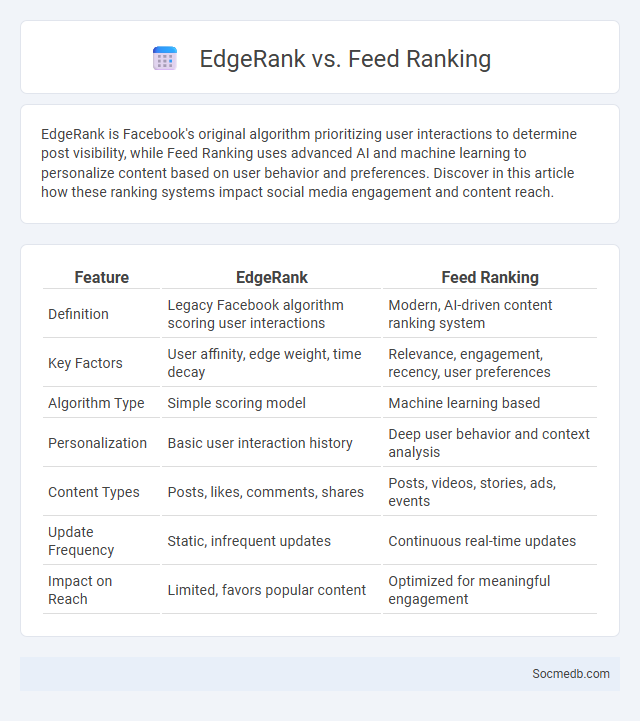
Photo illustration: EdgeRank vs Feed Ranking
EdgeRank is Facebook's original algorithm prioritizing user interactions to determine post visibility, while Feed Ranking uses advanced AI and machine learning to personalize content based on user behavior and preferences. Discover in this article how these ranking systems impact social media engagement and content reach.
Table of Comparison
| Feature | EdgeRank | Feed Ranking |
|---|---|---|
| Definition | Legacy Facebook algorithm scoring user interactions | Modern, AI-driven content ranking system |
| Key Factors | User affinity, edge weight, time decay | Relevance, engagement, recency, user preferences |
| Algorithm Type | Simple scoring model | Machine learning based |
| Personalization | Basic user interaction history | Deep user behavior and context analysis |
| Content Types | Posts, likes, comments, shares | Posts, videos, stories, ads, events |
| Update Frequency | Static, infrequent updates | Continuous real-time updates |
| Impact on Reach | Limited, favors popular content | Optimized for meaningful engagement |
Introduction to Facebook's Content Ranking Algorithms
Facebook's content ranking algorithms analyze billions of posts daily to prioritize what appears in your News Feed based on relevance and engagement. These algorithms use machine learning to evaluate factors like user interactions, content type, and freshness to personalize your experience. Understanding this system helps you optimize content, ensuring higher visibility and better audience engagement.
Understanding EdgeRank: The Original Algorithm
EdgeRank, the original Facebook algorithm, determines the visibility of posts by evaluating three key factors: affinity, weight, and time decay. Affinity measures the relationship strength between users and content creators, weight assigns importance to different types of interactions such as likes, comments, and shares, and time decay prioritizes newer posts to keep feeds relevant and fresh. Understanding EdgeRank helps marketers optimize engagement by tailoring content that matches users' preferences and interaction patterns.
Evolution to Feed Ranking: Why the Change?
Social media platforms evolved feed ranking algorithms to prioritize user engagement and content relevance, driven by the exponential growth of user-generated data and the need to enhance user experience. Machine learning models analyze user behavior patterns, preferences, and interactions to deliver personalized content, reducing information overload and increasing platform retention. This shift addresses challenges like misinformation spread and content saturation by promoting authoritative and meaningful posts in users' feeds.
Key Differences Between EdgeRank and Feed Ranking
EdgeRank is an early Facebook algorithm that prioritizes content based on affinity, weight, and time decay, determining which posts appear in users' news feeds. Feed ranking systems, however, use advanced machine learning techniques to analyze user behavior, engagement patterns, and content relevance in real-time, offering a more personalized and dynamic content delivery. Unlike EdgeRank's static formula, modern feed ranking algorithms incorporate diverse data signals to optimize user experience by promoting content likely to generate meaningful interactions.
Components and Signals: EdgeRank vs Feed Ranking
Social media platforms prioritize content using key components like user engagement, relevancy, and timeliness to optimize feed visibility. EdgeRank, an earlier Facebook algorithm, evaluated affinity, weight, and decay to determine which posts appeared in your feed, while modern feed ranking systems use machine learning models analyzing a broader range of signals such as user interactions, content type, and predicted user interest to personalize your experience. Understanding these components and signals helps you create more engaging content that ranks higher in social media feeds.
Impact on Organic Reach: What Marketers Need to Know
Organic reach on social media has declined significantly due to algorithm changes prioritizing paid content, pushing marketers to adapt strategies for visibility. Understanding platform-specific algorithms and optimizing content for engagement are crucial for maximizing organic interactions. Marketers must leverage authentic storytelling, timely responses, and community-building tactics to sustain organic reach despite increasing competition and paid ad saturation.
Relevance Score: The Modern Edge of Feed Ranking
Relevance Score is a critical metric used by social media platforms like Facebook and Instagram to determine the visibility of posts in users' feeds by evaluating engagement potential and content quality. Algorithms leverage this score to prioritize ads and organic posts that match user interests, behaviors, and past interactions, enhancing personalized content delivery. Higher Relevance Scores lead to improved feed ranking, resulting in increased reach, better user experience, and optimized advertising ROI for marketers.
Myths and Misconceptions About EdgeRank
EdgeRank, the algorithm once believed to solely dictate Facebook content visibility, is often misunderstood as the single influencer of user feed rankings. Myths claim EdgeRank's three components--affinity, weight, and time decay--function rigidly, ignoring the continual updates and machine learning models that now shape content prioritization. Misconceptions overlook Facebook's evolving algorithms that incorporate hundreds of factors beyond the original EdgeRank formula to personalize user experiences and optimize engagement.
Best Practices for Optimizing Content in Today's Feed
Maximize engagement by tailoring content to trending algorithms and utilizing high-quality visuals, relevant hashtags, and concise captions. Prioritize consistent posting schedules and interactive elements like polls or stories to boost visibility. Your content must resonate with the audience by leveraging data analytics to refine timing and format across platforms.
The Future of Facebook Feed Ranking Algorithms
Facebook feed ranking algorithms are increasingly leveraging advanced machine learning techniques and user behavior analysis to deliver highly personalized content. Innovations in artificial intelligence enable the algorithm to prioritize meaningful interactions and reduce misinformation while adapting to evolving user preferences. Future updates are expected to integrate more real-time data signals and contextual relevance, enhancing engagement and user satisfaction on the platform.
 socmedb.com
socmedb.com